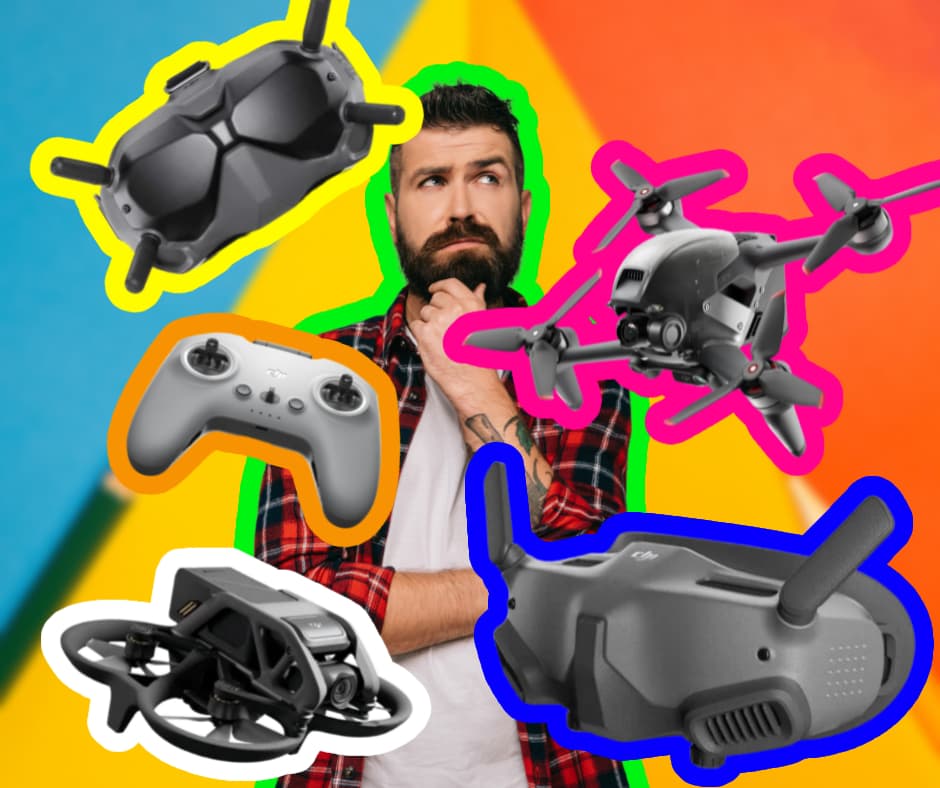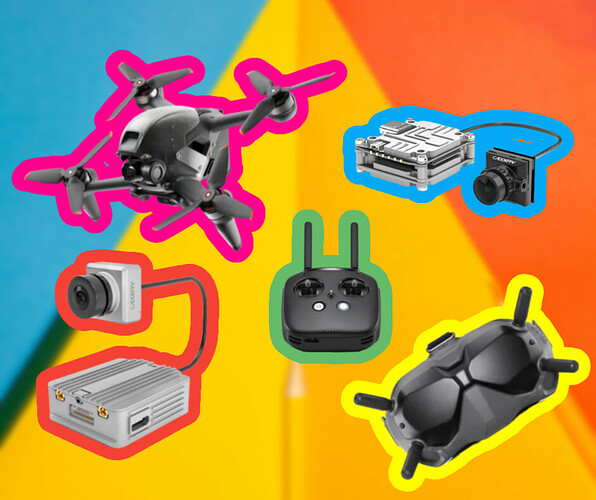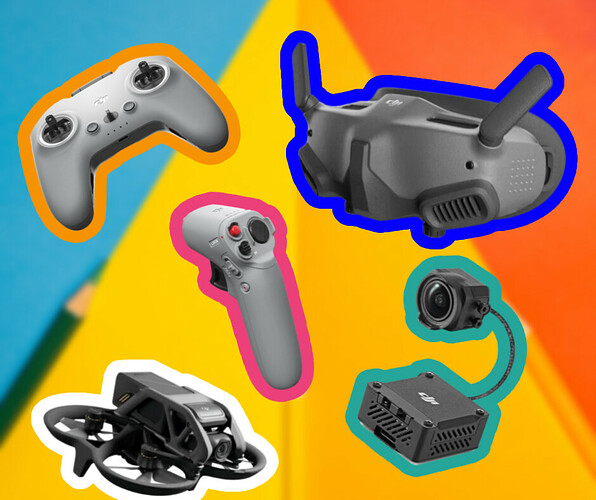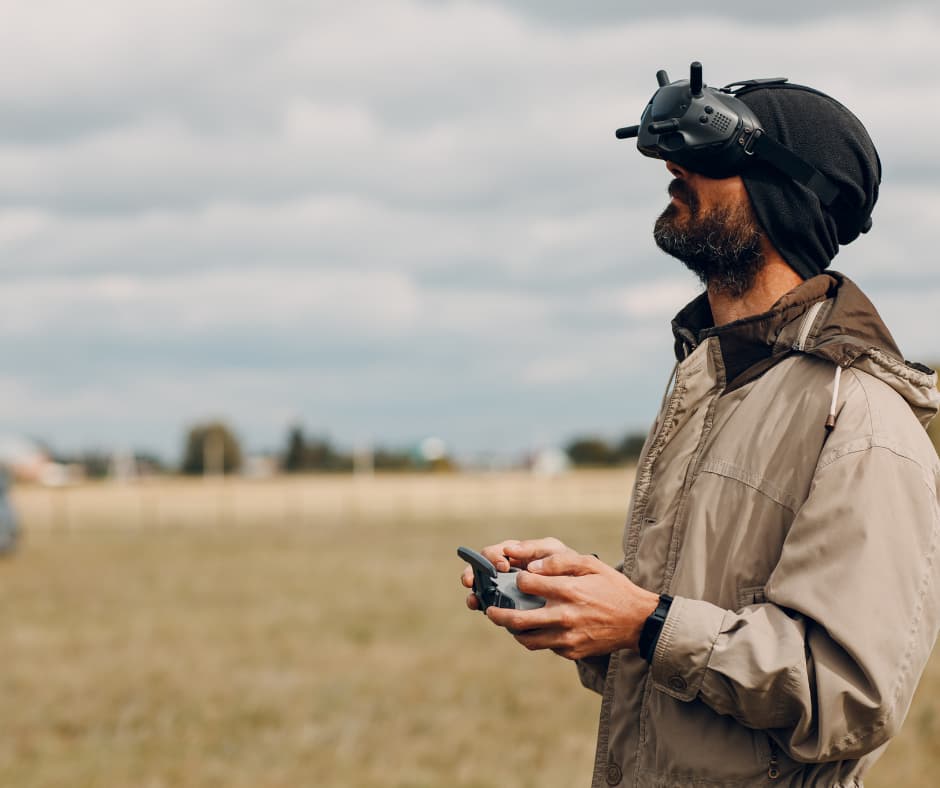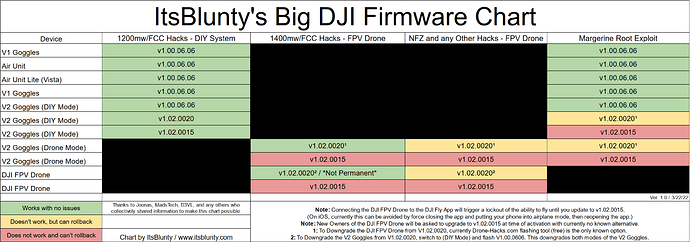If you’re new to the world of FPV drones or looking to upgrade your current setup, navigating the range of DJI FPV products can be overwhelming. Which components are compatible with each other? Do you lose certain features by mixing and matching? And what’s the best combination for your needs? In this article, we’ll break down the DJI FPV components and help you understand what works with what.
Quick‑look: three DJI digital generations
| Generation | Core goggles / radios | Native video link | Notable air‑units | Typical latency¹ |
|---|---|---|---|---|
| Gen 1 (OcuSync 2) | FPV Goggles V1 / V2 + RC 1 | 720p @ 120 fps | FPV Air Unit, Caddx Vista | 28 ms |
| Gen 2 (O3) | Goggles 2 / Integra + RC 2 | 1080p @ 100 fps | O3 Air Unit, Avata 1 | 30–40 ms |
| Gen 3 (O4) | Goggles 3 / N3 + RC 3 | 1080p @ 100 fps (improved codec & FEC) | O4 Air Unit (lite), O4 Pro Air Unit, Avata 2 | 30 ms (high‑speed mode) |
¹ End‑to‑end glass‑to‑glass latency at 25 Mbps, measured by DJI’s oscilloscope tests.
TL;DR – April 2025 Compatibility Matrix
Green = works; Red ✕ = won’t bind.
★ = needs latest firmware (details under the table).
| FPV Goggles V1 + RC 1 | FPV Goggles V2 + RC 1 | Goggles 2 / Integra + RC 2 | Goggles 3 / N3 + RC 3 | |
|---|---|---|---|---|
| FPV Air Unit | ✕ | |||
| Caddx Vista | ✕ | |||
| O3 Air Unit | ✕ | ✕ | ||
| O4 Air Unit (lite) | ✕ | ✕ | ||
| O4 Pro Air Unit | ✕ | ✕ |
Firmware footnotes
- ★ = Goggles 2 / Integra v01.00.06 or newer (“OcuSync‑2 compatibility” toggle).
- ★★ = O3 Air Unit & RC 2 v01.02.00 or newer.
- ★★★ = O4 branch v04.xx required on both air‑unit and RC 2 (adds a reduced‑FOV 40 ms mode); RC 3 unlocks the full 30 ms link.
Where does the Avata fit?
| Drone | Ships with | Internals | Binds to |
|---|---|---|---|
| DJI FPV Drone (2021) | FPV Goggles V2 + RC 1 | Gen 1 electronics (OcuSync 2 @ 720/120) | Any Gen 1 goggles, Goggles 2 w/★ |
| Avata 1 (2022) | Goggles 2 + RC Motion 1 | O3 transmitter | Goggles 2/Integra (720 or 1080) |
| Avata 2 (2024/25) | Goggles 3 or Goggles N3 + RC 3 | O4 Pro Air Unit | Goggles 3/N3 (native) · Goggles 2/Integra w/★★★ |
What changed since the last version of this post?
- DJI released a third digital link (O4) → brand‑new CRC scheme, lower packet overhead, still 1080p @ 100 fps but sharper after codec pass.
- Goggles 3 (plastic‑shell) and Goggles N3 (same internals, carbon‑look front plate) share the same radio.
- RC 3 adds two‑antenna O4 transceiver plus an ELRS‑style stick feel (longer throw & tension screws).
- O4 Air Unit (lite) weighs 34 g, no onboard DVR. O4 Pro keeps the SD‑slot (+ 4 K /60 gyro‑synced recording) yet shaves 6 g over the O3.
- Massive firmware drive: Goggles 2/Integra and RC 2 got O4‑compatibility in receive‑only mode — perfect if you’re mid‑upgrade and can’t stomach the price of Goggles 3 just yet.
Buying advice at a glance 
| If you… | Best route |
|---|---|
| Own Vista / Air‑Unit quads and need extra range | Stick with Goggles 2 + RC 2. Flash v01.00.06+, enable “OcuSync 2”. |
| Want the crispest DVR and shoot pro‑video | O4 Pro Air Unit + Goggles 3 + RC 3 – 4 K/60 gyro data and 30 ms link. |
| Fly sub‑250 g freestyle | O4 lite is 11 g lighter than O3 and pulls the same power at 700 mW. |
| Are on a budget / reuse old goggles | Vista is still unbeatable value (now £99 used) and works on all three goggle families. |
DJI FPV System Generations 1 and 2
Alrighty, let’s break down these DJI FPV components into two generations! And the key difference you need to pay attention to is image quality. The first-gen DJI HD FPV system can stream FPV video in 720p at 120 frames per second, which is pretty good. But the newer 2nd-gen FPV system can stream in full 1080p at 100fps – talk about crispy video! So if you’re all about that high-def life, the 2nd-gen system is the way to go.
The First Generation: Goggles V1, Goggles V2, Air Unit, Caddx Vista, Remote Controller V1, and DJI FPV Drone
Let’s start with the first generation of DJI FPV components: the Goggles V1/V2, the original Air Unit, and the original DJI Controller. The Goggles V1 have now been replaced by an upgraded version called Goggles V2, which look the same and have some slight upgrades. These were released along with the DJI FPV drone and run on the same first generation DJI FPV system.
The FPV Drone is DJI’s first drone designed specifically for FPV flying, with high-speed performance and advanced safety features. And the KMD Motion Controller provides a unique and intuitive way to control your drone.
While these products are no longer the latest and greatest, they can still work together seamlessly without the need for any extra equipment. That’s because they were designed from the start to work together. So if you’re looking for a budget option or want to upgrade your existing setup, these first-gen components are a good place to start.
DJI Air Unit VS Caddx Vista
About a year after the DJI Air Unit release, Caddx released the Vista, a mini air unit, here are some of the key differences
Some of the main differences between them are:
- Size and weight: The Caddx Vista is smaller (30x29x13mm) and lighter (19g) than the DJI Air Unit (44x37.8x14.4mm, 45.8g)
- Power output: The Caddx Vista has a maximum power output of 700mW, while the DJI Air Unit has a maximum power output of 1200mW. This means that the DJI Air Unit can provide longer range and better signal penetration than the Caddx Vista, but also generates more heat and consumes more battery power.
- Input voltage: The Caddx Vista supports up to 6S batteries (25.2V), while the DJI Air Unit only supports up to 4S batteries (16.8V). This gives more flexibility for choosing different battery voltages for different drone setups.
- DVR recording: The DJI Air Unit has a built-in DVR that can record HD video on a micro SD card, while the Caddx Vista does not have this feature. However, you can record video from both systems on your DJI FPV goggles.
But what about their limitations? The Goggles V1/V2, for example, have a lower resolution and field of view than the newer Goggles 2. And the original Air Unit is heavier than the newer O3 Air Unit. However, if image quality and weight aren’t your top priorities, these first-gen components can still provide a great flying experience at 720p resolution and 120 frames per second.
The Second Generation: Goggles 2, Avata, and More
Moving on to the second generation of DJI FPV components, we have the Goggles 2, the DJI Avata, the Motion Controller, the Remote Controller 2, the O3 Air Unit. These components were all designed to work together, and use the newer 2nd generation system that can stream full HD 1080p video at 100fps.
So what’s the advantage of this second-gen lineup? The Goggles 2 have a higher resolution and field of view than the V1/V2 goggles, and they’re also lighter and more comfortable to wear. The DJI Avata is an amazing drone that is the first to use the new second generation DJI FPV system. This small drone packs a punch with its 4K/60fps camera and 155° field of view, providing an immersive first-person view experience. And with built-in propeller guards that allow it to bounce back from collisions and the ability to support motion control by hand or head movements, it’s a pretty nifty piece of equipment. Plus, with HorizonSteady and RockSteady stabilization, the video footage is super smooth!
However, if you already have first-gen components and don’t want to upgrade everything, you’ll need to be careful about which second-gen components you choose (see our product compatibility table). For example, the Goggles V2 can work with both the first-gen Air Unit and the O3 Air Unit, but the Motion Controller only works with the Avata. However, DJI have been making firmware updates that add more backwards compatibility. So if you’re looking to mix and match, you’ll need to do some research and make sure everything is compatible.
Goggles V2 and Goggles 2?
Its some slightly confusion naming convention here, but the Goggles V2 are the older goggles that use the first generation FPV system, while the Goggles 2 are the newer system that are fully compatible with the second generation DJI FPV system.
Generation 3: Goggles 3 & N3, Avata 2 and the O4 Air Units
Gen 3 keeps the headline 1080p/100 fps spec but switches to a new radio stack:
- Better penetration – DJI claim +3 dB over O3 at 25 Mbps in CE mode.
- Lower encoding delay – new ASIC shaves ~5 ms, so the total ride is back to ~30 ms even with the extra FEC.
- Backward receive‑only – Goggles 3 can receive O3, but O3 transmitters can’t see the O4 protocol.
Early adopters report rock‑solid 10 km links on 700 mW with the O4 lite.
Conclusion: Making the Right Choice
So what’s the best combination of DJI FPV components for your needs? That depends on a variety of factors, including your budget, your flying style, and your desired features. But by understanding the differences between the first-gen and second-gen components, and by researching which ones are compatible with each other, you can make an informed decision that will provide the best possible flying experience.
Whether you’re a seasoned FPV pilot or just starting out, DJI has a range of products that can meet your needs. From the Goggles V1 to the O3 Air Unit to the DJI Goggles 2, there’s a component for every budget and every flying style. And by understanding how they all work together, you can build a setup that will give you the best possible experience. So go ahead and explore the world of DJI FPV – and happy flying!
April 2025 add‑on: If you’re planning a new build, budget for RC 3 – it’s the only transmitter that will follow DJI into whatever they launch next year, and it still talks happily to Gen 2 air‑units today.
